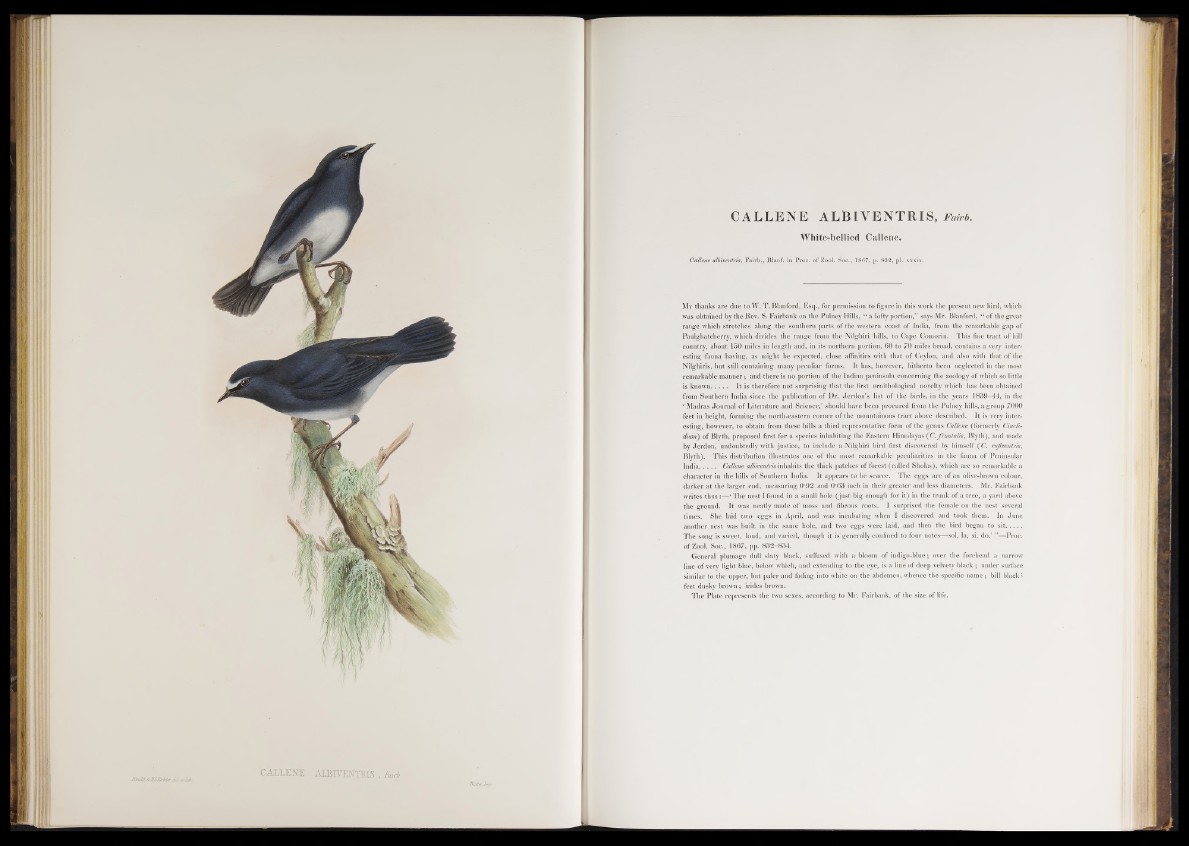
J.Gould/kECRuhttr, del eO ItfJi CALLENE ' ALBIVENTRIS , Mb.
Mdter.lmp.
CALLENE ALBIVENTRIS, Fairb.
White-bellied Callene.
Callene albiventris, Fairb., Blanf. in Proc. of Zool. Soc., 1867, p. 832, pi. xxxix.
My thanks are due to W. T. Blanford, Esq., for permission to figure in this work the present new bird, which
was obtained by the Rev. S. Fairbank on the Pulney Hills, “ a lofty portion,” says Mr. Blanford, “ of the great
range which stretches along the southern parts o f the western coast of India, from the remarkable gap of
Paulghatcherry, which divides the range from the Nilghiri hills, to Cape Comorin. This fine tract of hill
country, about 150 miles in length and, in its northern portion, 60 to 70 miles broad, contains a very interesting
fauna having, as might be expected, close affinities with that of Ceylon, and also with that o f the
Nilghiris, but still containing many peculiar forms. I t has, however, hitherto been neglected in the most
remarkable m anner; and there is no portion of the Indian peninsula concerning the zoology o f which so little
is known It is therefore not surprising that the first ornithological novelty which has been obtained
from Southern India since the publication of Dr. Jerdon’s list of the birds, in the years 1839-44, in the
‘ Madras Journal o f Literature and Science,’ should have been procured from the Pulney hills, a group 7000
feet in height, forming the north-eastern corner of the mountainous tract above described. It is very interesting,
however, to obtain from these hills a third representative form o f the genus Callene (formerly Cincli-
diuni) of Blyth, proposed first for a species inhabiting the Eastern Himalayas (C. f'ontalis, Blyth), and made
by Jerdon, undoubtedly with justice, to include a Nilghiri bird first discovered by himself ( C. rujiventris,
Blyth). This distribution illustrates one of the most remarkable peculiarities in the fauna of Peninsular
India Callene albiventris inhabits the thick patches of forest (called Sholas), which are so remarkable a
character in the hills of Southern India. It appears to be scarce. The eggs are of an olive-brown colour,
darker at the larger end, measuring 0 -92 and 0 ‘63 inch in their greater and less diameters. Mr. Fairbank
writes thus:— ‘The nest I found in a small hole (ju st big enough for it) in the trunk o f a tree, a yard above
the ground. I t was neatly made o f moss and fibrous roots. I surprised the female on the nest several
times. She laid two eggs in April, and was incubating when I discovered and took them. In June
another nest was built in the same hole, and two eggs were laid, and then the bird began to sit.........
The song is sweet, loud, and varied, though it is generally confined to four notes—sol, la, si, do.’ ’— Proc.
of Zool. Soc., 1867, pp. 832-834.
General plumage dull slaty black, suffused with a bloom of indigo-blue; over the forehead a narrow
line of verv light blue, below which, and extending to the eye, is a line o f deep velvety black ; under surface
similar to the upper, but paler and fading into white on the abdomen, whence the specific name; bill black;
feet dusky brown ; irides brown.
The Plate represents the two sexes, according to Mr. Fairbank, of the size of life.